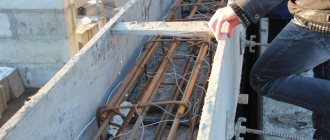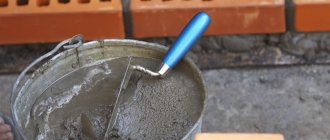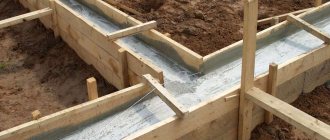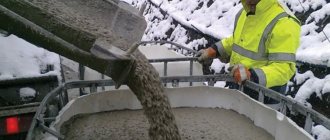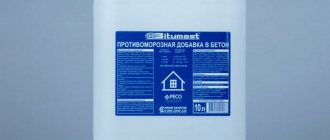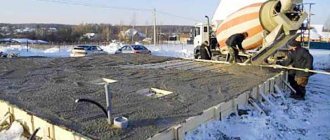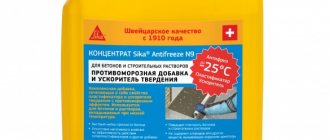When constructing buildings and carrying out activities to screed heated floor coverings, a dense and movable material is used - concrete. To improve its performance characteristics and increase resistance to temperature changes after hardening, a special plasticizer (additive) is added to the mixture at the preparation stage.
A plasticizing additive is a special composition that modifies concrete and prevents the formation of cracks. After its introduction, fluidity increases, the mixture fully fills voids and does not form air bubbles.
Application and purpose of plasticizers
Plasticizers for concrete are used at different stages of construction, so let’s figure out why they are needed and what types they are. Such additives make it possible to increase the strength of mixtures by 30%, reduce its consumption by 5%, and water consumption by a quarter.
Other positive qualities include the following:
- increasing the time of use of the finished solution;
- improving the quality of the material;
- increase in adhesive properties;
- ease of laying the mixture;
- frost resistance.
Workability
This indicator is also of paramount importance for concrete mixtures. Scientists have figured out that for complete hydration of cement, that is, for its complete hardening, a water-cement ratio of 0.25 is sufficient, but such a mixture cannot be placed normally in a mold or formwork.
Therefore, the amount of water is increased to a value of 0.5, in other words, the strength characteristics of the final product are deliberately worsened in pursuit of workability. But if you add a plasticizing additive, you can reduce the water-cement ratio to 0.4, which will give a 20% effect.
At the same time, the number of voids and capillary networks in the cement stone will be reduced. The workability or mobility of the mixture, which I wrote about in detail above, will be controlled using plasticizing additives.
Types of plasticizers
For the construction of monolithic structures, different types of concrete are used, which appeared thanks to the use of plasticizers. Supplements are divided into types, have different ways of working, amount of use and end result.
The main types of plasticizers for concrete are:
- Hydrophilic - reacting with water, which is found in all concrete mixtures. As a result of the chemical process, an astringent and fluid composition is formed. Once in the concrete solution, the plasticizer binds water molecules, which turns into a viscous mixture that interacts with cement, crushed stone and sand.
- Hydrophobic and hydrophobizing - during the hardening process, they push water out of the composition. The operating principle is based on saturating the mixture with microscopic air cavities, which in turn increases the insulating properties of the finished structure, removes excess moisture, and reduces the possibility of freezing of the poured solution.
Additives have different principles of application, contain additional components, and are accordingly divided into two types: dry and liquid plasticizers for concrete. Dry ones are presented in powder form. They can be used by adding to a dry mixture, or diluted with water and mixed with the main mass.
The liquid plasticizer has a high concentration and occupies no more than 1% of the total volume of the finished solution. One of the main features of this type of additive is that it replaces some of the water, which has a positive effect on hydration during the hardening process.
By origin, plasticizing mixtures are of three types:
- Organic – contains natural ingredients. They have a high concentration and are able to react quickly.
- Inorganic - made on the basis of special compounds that are suitable for organizing formaldehyde and other compounds.
- Organomineral - contain natural components and other types of minerals.
Superplasticizers
The influence of plasticizer on concrete mixture.
Modern plasticizing compositions are made in the form of complex mixtures of organic and mineral components. Such superplasticizers do not require the additional introduction of other additives, but affect the structure of concrete in a wide range, providing all the necessary properties. According to their main focus, such products are divided into chemicals that directly change the properties of the material due to direct chemical interaction, and fine-grained fillers that fill the volume and take on part of the functions of the solution, while ensuring cement savings.
Chemical compositions are divided according to the mechanism of action on the components of electrostatic and steric action. The group of steric plasticizers includes mixtures based on sulfonated naphthalene-formaldehyde polycondensates, sulfonated melamine-formaldehyde polycondensate ingredients, lingosulfonates after removing the sugar component, as well as on the basis of polycarboxylates and polyacrylates.
Material characteristics
Plasticizers have a low degree of volatility and are highly compatible with materials. The additive has no odor, the chemical composition does not affect the color of the material. This applies only to high quality raw materials, which do not release alkali during the mixing process.
Characteristics of certain types of plasticizers:
- can help improve fire resistance;
- resistance to ultraviolet radiation;
- improving heat resistance.
Some of the products may be highly specialized, but each of them increases the strength properties.
S – 3 (Russia)
- The famous superplasticizer, which appeared back in 1980 in the Soviet Union based on naphthalene sulfonic acid and formaldehyde.
- Allows you to obtain cast mixtures with mobility P4, P5.
- It makes it possible to reduce cement consumption by up to 25%, and also change the brand of Portland cement from M500 to M400.
- Sold in liquid and powder form.
- Compatible with all types of additives.
- When freezing, the solution does not lose its original properties.
- Mixed into the mixing water of the second addition.
- The powder must first be dissolved in water.
- Consumption: for mobile concrete and mortar mixtures – 0.2-0.8% by weight of cement; for self-compacting mixtures - 0.8-1.2% by weight of the binder.
- The cost of a 25 kg bag is from 2400 rubles.
Popular Supplement Brands
Plasticizers reduce water demand without changing the consistency of the mixture, while superplasticizers can significantly reduce the water content.
This category includes one of the popular brands of plasticizer for concrete, C3. The additive is produced using the method of organic synthesis of cellulose compounds. The result is surfactants that increase the strength of the concrete solution.
plasticizer for concrete C3
The Sika brand concrete plasticizer is a low-cost material intended for the production of concrete and reinforced concrete products and other structures. The additive in this series is highly compatible with aggregates and various types of cement. Capable of reducing water requirements by up to 40%, resulting in a strong and durable concrete matrix.
One of the popular additives for accelerating the strength gain of concrete, increasing its frost resistance and water resistance is the TechnoNIKOL plasticizer. It is produced in liquid form and is used for all types of foundations, blind areas, door and window slopes, and is used when installing heated floors.
plasticizer TechnoNIKOL
Tools required for work
To prepare a concrete mixture intended for floor screed with the addition of a plasticizer, the following tools are required:
- construction mixer;
- shovel;
- pallet type container;
- scales;
- measuring bucket;
- measuring cone for solution;
- Master OK;
- putty knife;
- trowel;
- thermometer;
- level.
Plasticizers for floor screeds are offered in a wide range and for different conditions. The use of standard mixtures in compliance with all the conditions set out in the instructions allows us to ensure the required quality of the screed, which is especially important in the manufacture of heated floors. In some cases, plasticization can be done with your own hands using simplified compounds.
Material consumption
The consumption of plasticizer for concrete depends on its release form. For example, a liquid additive must be measured in a ratio of 0.5-1 liter per 100 kilograms of cement used for the construction of walls, floor screeds, and ceilings. 1-2 liters are needed per 100 kilograms of cement for self-compacting concrete, used for pouring foundations and forms for complex reinforced concrete load-bearing structures.
Dry plasticizer is presented in the form of a powder, which must be added to the source material, after diluting it with water. The solution should have a concentration of 15-35%.
To determine how much plasticizer to add to concrete, you must use the dosage indicated on the packaging, since manufacturers may indicate different proportions of additive use.
To finally determine the concentration of the plasticizing additive, it is necessary to find out how much cement will be used to prepare the mixture. Household concrete mixers are designed for 10-15 kg of cement, so it is more convenient to use a standard container, for example, a liter jar. If the packaging indicates from 0.5 to 1%, the optimal proportion of plasticizer for concrete will be approximately 0.7%.
Recommendations
Working with cement mortar is relatively simple, but has a number of pitfalls:
- If you need to drill a hole, it is important to choose the right tool and drill. The most effective procedure is diamond drilling of holes in concrete or using a pobedit drill;
- To create high-strength, loaded structures, a metal frame must be laid. It is important to understand how reinforcement works in concrete in order to create the strongest possible structure. The best technical characteristics are provided by the reinforcement cage and fiber for concrete;
- The decorative qualities of cement are quite low; most often it is treated with a topcoat. There is an alternative option - grinding, it helps to eliminate protrusions and improve the appearance of the material. Several effective ways have been developed to polish concrete;
- the thermal insulation characteristics of any monolithic base are inferior to porous materials. Porous concrete blocks retain heat, create less load on the foundation and are easier to lay, but are not suitable for the construction of multi-story buildings.
Making your own plasticizer
To replace the plasticizer for concrete, you can prepare it yourself.
One of the easiest ways is to use powder, liquid soap or shampoo. When the concrete mixture is mixed, it produces foam. The calculation is made according to the weight of the cement; 1 bag will take approximately 200 grams of powder or 200 milliliters of any substance.
When plastering surfaces, you can use slaked lime in proportions of 200 grams per 1 kilogram of concrete. The solution will become quite elastic and its ability to stick together will increase.
When using soapy substances, efflorescence may appear on the dried surface, which is a disadvantage of using home remedies. But if you add glue to the mixture, you can avoid such problems.
The glue will not spoil the solution, and cracks will not appear when it dries. The product should be used per 10 liters of solution - 200 milligrams of glue.
A homemade plasticizer for concrete has a low cost, but one of its main disadvantages is the appearance of a large amount of foam. Therefore, in this case it is better to use components with reduced foaming or wait until the bubbles settle.
Why is concrete cast at low temperatures?
If temperatures below +5°C are harmful to concrete, why is concrete work carried out in such conditions?
The answer is simple: sometimes there is simply no choice.
There are many regions in Russia where optimal temperature conditions for concreting appear for a very short time. In fact, it is late spring or early autumn. It would be strange to cancel construction work the rest of the year.
But this is not the only reason; Sometimes winter concreting is done deliberately for the following reasons:
- in winter prices for building materials may be lower;
- on soft soils, in some cases, concreting foundations is possible only in winter;
- It is easier for heavy equipment to drive through frozen access roads.
Advantages of using a plasticizer for concrete
The use of plasticizing additives has many positive aspects, among which are:
- High quality and optimal price. With the use of a plasticizer, cement consumption is reduced by approximately 25%, which makes it possible to reduce costs.
- Increasing the life time of the mixture by 4-5 hours if long-term transportation is necessary. In this way, you can save time that could have been spent constantly stirring the finished solution.
- Increase in composition strength by approximately 20%. In practice, it has been proven that work with the base can be started earlier; there is no need to wait 28 days for the concrete to cure.
- Increased drying time. This advantage will make it possible to pour the foundation in several stages without knocking down the top layer of concrete. This will only increase the strength and prevent cracks from appearing on the surface.
- Possibility to use special equipment. When constructing objects, low-elasticity mortar must be lifted to the floors manually. With the use of a plasticizer, its elasticity increases, which makes it possible to attract the gas pump to work.
- When laying the mixture, there is no need to use a vibration compactor. This tool is designed to mix the solution and remove excess air bubbles. Due to the fact that the concrete mixture becomes mobile, there is no need to use a vibrating compactor.
- Maximum filling of voids. Thick concrete does not easily fall through a large amount of reinforcement; with the addition of a plasticizing agent, this problem will disappear. Thanks to this, the base becomes more durable and will not crack under heavy load.
- Increased waterproofing. The solution becomes thicker, and at sub-zero temperatures the risk of concrete rupture is reduced.
Tips for choosing
When choosing additives for concrete, they take into account the operating circumstances of the future structure, pouring conditions, the method of work used, the brand and composition of cement, ambient temperature, quality of the additive, etc. The most commonly used substances are sodium chloride for rapid hardening, sodium nitrite, potash for Portland cement.
Typically, an additive is selected according to its action and needs - after carefully studying the properties of a particular additive, the one that meets the conditions and requirements is selected. In special cases, they turn to specialists.
Features of choosing a substance:
- In structures with non-prestressed reinforcement with a cross-section of more than 5 millimeters, any additives can be used, except those that cause corrosion.
- If the cross-section of the reinforcement is less than 5 millimeters, HC, NN and HC cannot be used.
- When there is a release of reinforcement and embedded elements, and steel without protection, NKM, P, NN, NK, SN are suitable. If the steel has a combined coating, it is prohibited to use CC and NN.
- When operating with constant immersion of a concrete structure, all types of additives are used.
- SN, NK, NKM, NN are suitable for conditions of variable influence of aggressive water on the structure.
- For structures that are constantly operated in an aggressive gas environment, CC is not used.
Antifreeze additives in concrete allow work to be carried out in any conditions without compromising the quality and strength of the monolith. Provided that the additive is chosen correctly and the technology is followed, good results can be achieved.
Briefly about the main thing
- The most important formula for a concrete and mortar mixture will be the water-cement ratio (W/C). The lower this indicator, the stronger the structure will be after hardening. You need to strive for an indicator of 0.5.
- An ideal W/C can be achieved by using plasticizers and superplasticizers. Plasticizers will also help reduce cement consumption, and, consequently, the cost of construction work.
- When preparing mixtures using chemical additives, you must use protective equipment to protect yourself from damage and toxic substances getting into the respiratory tract and eyes. In case of contact with skin, wash off with soap.
- Stir the plasticizer first in water, and only then add it to the concrete mixer. Water for diluting powder or paste plasticizer should be heated to 60-90 C.
As always, we look forward to your questions and advice.
If you liked the article, share it on social networks. This will help them get useful information and support our project.

